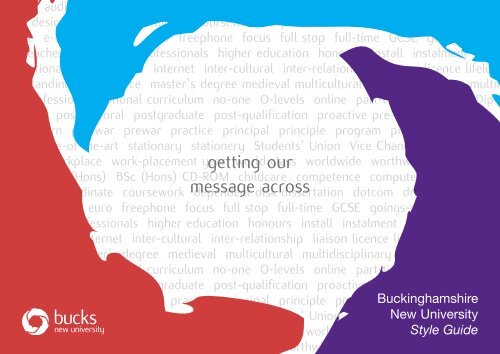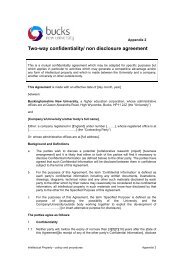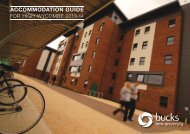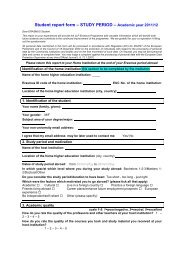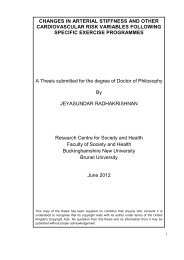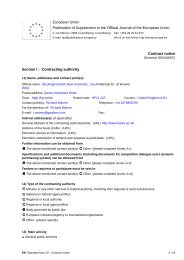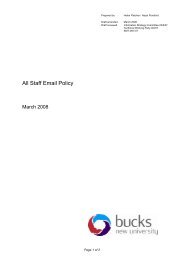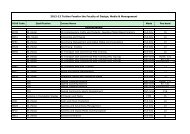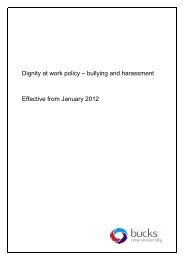Buckinghamshire New University style guide
Buckinghamshire New University style guide
Buckinghamshire New University style guide
You also want an ePaper? Increase the reach of your titles
YUMPU automatically turns print PDFs into web optimized ePapers that Google loves.
-level audio-visual BEng (Hons) BSc (Hons) CD-ROM childcare competence computer<br />
ided design cooperate coordinate coursework dependent disk dissertation dotcom drivi<br />
icence e-learning email euro freephone focus full stop full-time GCSE goings-on<br />
eadteacher health care professionals higher education honours install instalment<br />
nternational Baccalaureate internet inter-cultural inter-relationship liaison licence lifelong<br />
ong standing marketplace master's degree medieval multicultural multidisciplinary multim<br />
ultiprofessional national curriculum no-one O-levels online part-time PGCert PGDip<br />
ostcode postdoctoral postgraduate post-qualification proactive pre-qualification<br />
ostmodern postwar prewar practice principal principle program programme semi-co<br />
outh state-of-the-art stationary stationery Students' Union Vice Chancellor vocational<br />
ebsite workplace work-placement year getting world our class worldwide worthwhile A-level aud<br />
isual BEng (Hons) BSc (Hons) CD-ROM childcare competence computer-aided design<br />
ooperate coordinate coursework message dependent disk across dissertation dotcom driving licence e-<br />
earning email euro freephone focus full stop full-time GCSE goings-on headteacher<br />
ealth care professionals higher education honours install instalment International<br />
accalaureate internet inter-cultural inter-relationship liaison licence lifelong long stand<br />
arketplace master's degree medieval multicultural multidisciplinary multimedia<br />
ultiprofessional national curriculum no-one O-levels online part-time PGCert PGDip<br />
ostcode postdoctoral postgraduate post-qualification proactive pre-qualification<br />
ostmodern postwar prewar practice principal principle program <strong>Buckinghamshire</strong><br />
programme semicol<br />
outh state-of-the-art stationary stationery Students' Union Vice Chancellor <strong>New</strong> <strong>University</strong> vocational<br />
ebsite workplace work-placement year world class worldwide Style Guide<br />
worthwhile
When we became <strong>Buckinghamshire</strong><br />
<strong>New</strong> <strong>University</strong> in October 2007, a<br />
new corporate identity was drawn up<br />
to reflect the <strong>University</strong>’s vibrancy<br />
and dynamism. This should be used<br />
consistently throughout our written<br />
and online publications and<br />
materials.<br />
Our writing <strong>style</strong> should also reflect<br />
the ethos of the <strong>University</strong>. We need<br />
to write in a way that engages the<br />
reader and gives the best<br />
impression. The reader should be<br />
able to understand a document at<br />
first reading and in the same sense<br />
that the writer meant it to be<br />
understood.<br />
introduction<br />
General writing tips<br />
Aim to be as clear and concise as possible. Using plain English does not mean<br />
you are dumbing down your text, rather that you are simply delivering your<br />
message in the clearest way possible. This will help you create the greatest<br />
impact. Remember that you are writing for a mixed audience – English may not be<br />
the first language of many of your readers.<br />
Keep it positive<br />
Our courses are definitely not traditional. They are designed to ensure that<br />
graduates hit the ground running when they embark on their working lives. Try and<br />
reflect this when writing about the <strong>University</strong> and its courses.<br />
Aim to attract your reader’s attention from the beginning. Keep sentences short.<br />
When writing for the web in particular, break your text into paragraphs two or<br />
three sentences long. Be direct, and when you need to impart more detailed<br />
information do so clearly and without using jargon.<br />
Example:<br />
Foundation degrees are exciting, vocational degrees, designed to give you a<br />
flying start towards your chosen career. If you’re already in work, they can<br />
provide you with extra skills to enhance your promotion prospects. Once you<br />
achieve the award, you’re able to add the letters FDA or FDSc after your<br />
name. You can also progress to an honours degree or to professional<br />
qualifications.<br />
2 <strong>Buckinghamshire</strong> <strong>New</strong> <strong>University</strong> Style Guide
Keep it as natural as possible<br />
Writing he or she, he/she or (s)he can look clumsy. Use ‘they’ to cover both<br />
genders, just as you would if you were speaking.<br />
Example:<br />
Before a student comes to an interview, they [not he or she] may find it<br />
helpful to visit our website for directions.<br />
introduction<br />
Examples of poor written English<br />
1 "I would not ever want to say<br />
there are not people on our<br />
campus that at first in the<br />
classroom are not hard to<br />
understand, at least until<br />
students get used to them,"<br />
Watkins said.<br />
Keep it friendly<br />
It is quite acceptable to use the second person, especially when communicating<br />
with students. Call readers you, even if there are lots of them. For the <strong>University</strong> or<br />
your directorate, use we.<br />
Example:<br />
We have an exciting new portfolio of courses starting in January. You will find<br />
more details on our website.<br />
When you are writing formal reports or documents, you may need to be more<br />
formal, and use the <strong>University</strong> or the Dean, for example, rather than we.<br />
2 Operationally, teaching<br />
effectiveness is measured by<br />
assessing the levels of<br />
agreement between the<br />
perceptions of instructors and<br />
students on the rated ability of<br />
specific instructional behaviour<br />
attributes which were employed<br />
during course instruction.<br />
3 In our endeavour to ensure<br />
guest safety at all times, can<br />
visitors please note that fire bell<br />
testing is carried out every<br />
Monday at 9.30am.<br />
See page 41 for suggested<br />
improvements.<br />
<strong>Buckinghamshire</strong> <strong>New</strong> <strong>University</strong> Style Guide 3
Examples of poor written English<br />
4 Reclamation of the site will involve<br />
the identification and remediation<br />
of any pollution and contamination<br />
which may be present on the site<br />
together with the removal or<br />
treatment of hazardous features<br />
such as unstable ground and<br />
mineshafts etc.<br />
5 The department is required to<br />
make savings of £13m next year<br />
and this objective will be achieved<br />
by efficiency savings. An<br />
evaluation of cash collection<br />
methods and procedures and<br />
identification of potential savings<br />
in this area have been conducted<br />
by senior management and<br />
determined to be part of this<br />
overall process.<br />
See page 41 for suggested<br />
improvements.<br />
introduction<br />
16 tips on writing plain English<br />
1 Consider carefully your purpose and message before starting to write – clear<br />
writing and clear thinking go hand in hand.<br />
2 Wear the reader’s shoes – how would you feel in their position?<br />
3 Plan a structure that will help the reader, perhaps with headings, bullet-points,<br />
and a pithy summary of key points at the start.<br />
4 In letters and emails, tell the reader clearly, concisely and courteously what has<br />
happened, how the situation stands, and what they can expect next.<br />
5 Match your writing to the needs and knowledge of the readers – some of them<br />
may be baffled by official jargon and procedures.<br />
6 Write sentences that average 15–20 words.<br />
7 Keep the word order simple. In most sentences, put the ‘doer’ early and follow it<br />
with an active-voice verb.<br />
8 Take pride in using everyday English, correct grammar and accurate punctuation.<br />
9 Where appropriate, use I, we and you to make the writing more personal.<br />
10 Maintain the flow by starting some of your sentences with connectors like<br />
however and so.<br />
11 Use commands when writing instructions.<br />
12 Cut unnecessary words.<br />
13 Check that the facts and judgement are right. Nothing compensates for<br />
inaccuracy or illogicality.<br />
14 Ask someone else to read your documents before they are issued.<br />
15 Apply common sense to all guidance about writing.<br />
16 If you are asking someone to do something, put your request towards the start of<br />
the email or document.<br />
4 <strong>Buckinghamshire</strong> <strong>New</strong> <strong>University</strong> Style Guide
Accessibility and dyslexia<br />
When preparing support material for students with accessibility issues (for<br />
example dyslexia) here are some points that you should bear in mind:<br />
• text should be left aligned<br />
• use Arial at 12 point or greater, wherever possible<br />
• keep a clear uncluttered layout<br />
• ensure words are not split between lines<br />
• avoid large blocks of capital letters<br />
• avoid italics<br />
• avoid underlining words<br />
• keep the use of punctuation such as commas, semi-colons and full stops<br />
to a minimum<br />
• make sure text is not placed over the top of an image or texture<br />
• ensure good contrast between the text and background<br />
• do not convey information solely through the use of images, diagrams or colour<br />
• maintain adequate spacing.<br />
All publications should contain the following statement:<br />
This publication is available in alternative formats if required.<br />
introduction<br />
Examples of poor written English<br />
6 LSC and HEFCE announced<br />
today that they were launching a<br />
joint FE/HE funding initiative.<br />
One of the fundamental building<br />
blocks of this scheme is a joined<br />
up approach to creating a ladder<br />
of educational opportunity for<br />
learners of all ages.<br />
7 In order to take ownership of the<br />
problem and impact the<br />
situation, going forward, I would<br />
like to encourage dialogue<br />
between all my colleagues and<br />
myself. Bring along to my office<br />
your shopping lists for action.<br />
See page 41 for suggested<br />
improvements.<br />
Don’t forget to ask whether participants have special requirements (physical or<br />
dietary) when you are organising a meeting or event.<br />
<strong>Buckinghamshire</strong> <strong>New</strong> <strong>University</strong> Style Guide 5
A<br />
A words<br />
accommodation<br />
advice (noun), to advise (verb)<br />
adviser (not advisor)<br />
affect (make a difference to)<br />
ageing (not aging)<br />
A-level<br />
all right (your answers are all right)<br />
alright (are you alright?)<br />
alumni (plural)<br />
alumnus/alumna (singular)<br />
alumnae (plural female)<br />
amend, amendment<br />
among, not amongst<br />
analyse<br />
AS-level<br />
audio-visual<br />
autumn, spring, summer, winter<br />
A–Z <strong>guide</strong><br />
Accents<br />
Only use accents on foreign words, and don’t do so if the word has been<br />
anglicised, eg cafe, fiance.<br />
Exceptions:<br />
Précis<br />
Exposé (to distinguish from expose)<br />
To insert accents in Word documents go to the Insert menu and choose Symbol.<br />
Acronyms and abbreviations<br />
Peppering your documents with capitals and abbreviations can be confusing to<br />
your readers. Don’t assume everyone knows what the initials stand for – unless<br />
the organisation concerned is commonly referred to in its abbreviated form, for<br />
example BBC, RAC.<br />
Write out the full name the first time you use it, followed by the shortened version<br />
in brackets. After that, just use the abbreviation. (If you only use the term once,<br />
then you don’t need to add the abbreviation in brackets unless it is a useful piece<br />
of information.)<br />
Example:<br />
The School of Design, Craft & Visual Arts (DCVA) offers a wide range of<br />
courses in the creative industries. DCVA offers an exciting range of vocational<br />
programmes.<br />
Note: When using initials, plurals do not take an apostrophe and the ‘s’ is lower<br />
case, eg LAs.<br />
6 <strong>Buckinghamshire</strong> <strong>New</strong> <strong>University</strong> Style Guide
Addresses<br />
When writing addresses, avoid unnecessary punctuation. The address should not<br />
contain:<br />
• full stops at the end of addresses<br />
• a comma between the number and the street name<br />
• abbreviated forms of Road, Street or Avenue<br />
• a comma between the town/county and postcode.<br />
The postcode should appear after the town or city on the next line. Both<br />
<strong>Buckinghamshire</strong> and Bucks are acceptable.<br />
Example:<br />
Strategic Marketing & Communications Directorate<br />
<strong>Buckinghamshire</strong> <strong>New</strong> <strong>University</strong><br />
Queen Alexandra Road<br />
High Wycombe<br />
Bucks<br />
HP11 2JZ<br />
Occasional variations may be permitted, in order to comply with computer<br />
systems already in use.<br />
A–Z <strong>guide</strong><br />
Awards<br />
A-level<br />
BA (Hons)<br />
BEng (Hons)<br />
BSc (Hons)<br />
FDA<br />
FDSc<br />
GCSE<br />
MA<br />
MPhil<br />
PGCert<br />
PGCE<br />
PGDip<br />
PhD<br />
A<br />
American English<br />
Beware American usage of words and spelling, for instance, capitalizing (rather<br />
than the English capitalising), or gum (glue), trunk (boot of a car), color, favorite,<br />
theater etc. You can change the default language settings in Word to UK English.<br />
<strong>Buckinghamshire</strong> <strong>New</strong> <strong>University</strong> Style Guide 7
A<br />
Abbreviations<br />
ext<br />
fax<br />
tel<br />
A–Z <strong>guide</strong><br />
Ampersand<br />
The ampersand (&) is used in our faculty, school and directorate titles.<br />
Examples:<br />
Faculty of Design, Media & Management.<br />
Welcome to the School of Advanced & Continuing Practice, which is located<br />
in the Faculty of Society & Health.<br />
Apostrophes<br />
Apostrophes have a variety of uses:<br />
• omissive - when you’re contracting two words, eg: don’t, shouldn’t, couldn’t<br />
• when you are describing a period of time, eg: two years’ experience, four<br />
months’ work, 48 hours’ training<br />
• possessive - when something belongs to somebody/thing, eg: Judith’s book,<br />
the <strong>University</strong>’s mission, the world’s resources<br />
• words and names ending in s also take a singular s eg: James’s, Bucks’s<br />
• plural nouns take a singular apostrophe, eg: children’s games, old folk’s home.<br />
Don’t use an apostrophe to form a plural with numbers and letters:<br />
• 1990s not 1990’s<br />
• three As at A-level<br />
• CDs (not CD’s)<br />
Don’t use an apostrophe in the contraction its (belonging to it) eg: Its CD drive is<br />
broken.<br />
Audience<br />
Think about who you are writing for. Most of our writing <strong>style</strong> <strong>guide</strong>lines will apply<br />
to the majority of audiences, but you may need to change the tone for different<br />
audiences and in different circumstances, for instance if you are writing a formal<br />
letter or academic paper.<br />
8 <strong>Buckinghamshire</strong> <strong>New</strong> <strong>University</strong> Style Guide
Branding<br />
Our new corporate identity is designed to reflect not only our new name, but what<br />
we stand for as an institution. More information can be found in our Brand<br />
Guidelines or at bucks.ac.uk/branding. Please note that you must read the Brand<br />
Guidelines before downloading <strong>University</strong> logos, and that all usage must be<br />
approved by the Strategic Marketing & Communications Directorate. Incorrect<br />
usage will detract from the strength of the branding.<br />
<strong>Buckinghamshire</strong> <strong>New</strong> <strong>University</strong><br />
The full name should be used on formal documents, such as certificates,<br />
contracts, transcripts, letters and governing body materials. We use the shorter<br />
form Bucks <strong>New</strong> <strong>University</strong> as an alternative in some circumstances, for instance<br />
in marketing materials.<br />
A–Z <strong>guide</strong><br />
B words<br />
BA (Hons)<br />
bachelor’s degree<br />
benefit, benefited, benefiting<br />
BEng (Hons)<br />
BSc (Hons)<br />
budgeted<br />
B<br />
‘Bucks’ is used as the abbreviated form of our name provided there is no<br />
likelihood of confusion with the county name. BNU is not an acceptable<br />
abbreviation of the <strong>University</strong> name; we use bucks.ac.uk as our web address, and<br />
use bucks in our email addresses. Use the full name in the first instance, followed<br />
by a shorter form.<br />
Example:<br />
<strong>Buckinghamshire</strong> <strong>New</strong> <strong>University</strong> (Bucks) has been ranked number one in an<br />
index designed to measure the quality of life of academic staff at 121 higher<br />
education institutions in the UK.<br />
Bucks Students’ Union<br />
This is the full name of our Students’ Union.<br />
<strong>Buckinghamshire</strong> <strong>New</strong> <strong>University</strong> Style Guide 9
B<br />
A–Z <strong>guide</strong><br />
Bullet points (see also lists, presentations and numbering of paragraphs)<br />
Where the list consists of single words or brief phrases that relate to the previous<br />
sentence all initial letters should be lower case. Punctuate as follows:<br />
Example:<br />
The open day programme includes:<br />
• tours of the <strong>University</strong><br />
• visits to halls of residence<br />
• talks on finance<br />
• visits to academic departments.<br />
Where the list consists of short sentences or phrases related to the previous<br />
sentence initial letters should be lower case. Punctuate as follows:<br />
Example:<br />
The course was designed to:<br />
• introduce students to basic concepts;<br />
• familiarise students with the terminology;<br />
• provide basic relevant statistics.<br />
Where the list consists of longer, complete sentences, punctuate as for normal<br />
sentences:<br />
Example:<br />
Here’s some information you may find of interest:<br />
• Bucks had nearly 7,000 students on all levels of study in 2007-08, including<br />
5,224 students on undergraduate courses.<br />
• We welcome significant numbers of mature students, with more than a third<br />
of the population being over the age of 25.<br />
10 <strong>Buckinghamshire</strong> <strong>New</strong> <strong>University</strong> Style Guide
Bullet points (continued)<br />
Bullet points can help to break up text and make it easier to read and digest.<br />
Solid round bullet points should be used. If you need to use secondary bullet<br />
points, you should use open round bullet points.<br />
When using bullet points in presentations, remember:<br />
• the bullet point should be a short summary of a key point, not an entire<br />
sentence;<br />
• bullet points should follow a consistent <strong>style</strong>;<br />
• as a <strong>guide</strong>line, slides should not have more than six bullet points and each<br />
bullet should be no more than six words;<br />
• bullet points alone can be boring – add pictures, diagrams, audio clips or videos.<br />
Campuses<br />
From September 2009, we have two distinct campuses:<br />
• High Wycombe Campus is a short walk from the bus and train stations in High<br />
Wycombe on Queen Alexandra Road.<br />
• Our Uxbridge Campus allows Nursing students to be close to the clinical areas<br />
where they undertake their placements.<br />
Example:<br />
There will be a shuttle bus service from our High Wycombe Campus to the<br />
student accommodation in Hughenden.<br />
A–Z <strong>guide</strong><br />
C words<br />
cafe<br />
capitalise, capitalising<br />
CD-ROM<br />
childcare<br />
competence, competences<br />
(National Vocational<br />
Qualifications; functional skills)<br />
competency, competencies<br />
(behavioural trait; functional and<br />
behavioural skills combined)<br />
complement (that which<br />
completes or fills up)<br />
compliment (expression of<br />
admiration)<br />
B-C<br />
computer-aided design<br />
continuous (without interruption)<br />
continual (happening frequently)<br />
cooperate, cooperation,<br />
cooperative<br />
coordinate, coordinator<br />
council (an administrative or<br />
advisory body)<br />
counsel (advise/guidance)<br />
coursework<br />
<strong>Buckinghamshire</strong> <strong>New</strong> <strong>University</strong> Style Guide 11
C<br />
A–Z <strong>guide</strong><br />
Capitals<br />
Keep your use of capitals to a minimum. Capital letters interrupt the flow of the<br />
eye across the page. Think about why you use them. Would you leave your House<br />
in the morning to go to your Job? No. So why should a student leave their Hall of<br />
Residence to meet a Tutor? You don’t need to capitalise when referring to<br />
something in general.<br />
Example:<br />
The <strong>University</strong>’s academic structure is now built around two faculties, which<br />
are sub-divided into schools.<br />
Subject disciplines should not be capitalised, but course titles should:<br />
• MEng Mechanical Engineering Design<br />
• the programme includes lectures in history of art, computing and geography.<br />
But, if you are using official titles, use capitals.<br />
Examples:<br />
The School of Design, Craft & Visual Arts in the Faculty of Design, Media &<br />
Management can provide you with an awareness of cultural issues, as well as<br />
a strong grasp of marketing and communication principles.<br />
The School of Applied Management & Law has an excellent reputation.<br />
Don’t use capital letters in headings, except at the beginning and for proper<br />
nouns.<br />
Examples:<br />
Sports students stage tag rugby festival<br />
Sports Management and Rugby Studies students from <strong>Buckinghamshire</strong> <strong>New</strong><br />
<strong>University</strong> staged a tag rugby festival at the home of London Wasps.<br />
12 <strong>Buckinghamshire</strong> <strong>New</strong> <strong>University</strong> Style Guide
Capitalising job titles (see job titles)<br />
Capitalising historical periods and events<br />
Capitalise names of widely recognised epochs in anthropology, archaeology,<br />
geology and history, for example the Bronze Age, the Dark Ages, the Middle Ages,<br />
the Renaissance, the Victorian era, the Enlightenment, the Third Reich. Also<br />
capitalise periods named after specific dynasties or people, for example the<br />
Tudors, Elizabethan. Use lower case for medieval, baroque.<br />
A–Z <strong>guide</strong><br />
C<br />
Art movements:<br />
Art Deco, Art Nouveau, Cubism, Dadaism, Gothic, Impressionism, Pop Art,<br />
Rococo, Surrealism, Arts and Crafts movement etc.<br />
War:<br />
First World War, Second World War; Crimean/Boer/Vietnam/Gulf War; Hundred<br />
Years War.<br />
Capitalising proper nouns<br />
Names of people, places, countries and organisations should take capital letters.<br />
Examples:<br />
John Smith, High Wycombe, Missenden Abbey Conference Centre<br />
Commas<br />
It is acceptable to put a comma before and, particularly in longer sentences or<br />
lists.<br />
<strong>Buckinghamshire</strong> <strong>New</strong> <strong>University</strong> Style Guide 13
C<br />
Copyright<br />
Creative work such as books,<br />
poems, pictures, drawings, music,<br />
and films, may be protected by<br />
copyright. If you are uncertain about<br />
whether you are able to use a piece<br />
of writing, diagram or picture, you<br />
should seek the express permission<br />
of the originator. If you don't have<br />
permission, then you shouldn't use<br />
that piece of work.<br />
For further information, and guidance<br />
on copyright relating to your own<br />
work, read the IPR and Copyright<br />
Policy which can be found on the<br />
Bucks website at bucks.ac.uk.<br />
A–Z <strong>guide</strong><br />
Committees<br />
Committee minutes and associated papers are a record of the business and<br />
academic decision-making of the <strong>University</strong>, and are written in a formal <strong>style</strong>.<br />
The Quality Unit in the Student & Academic Services Directorate is responsible for<br />
many <strong>University</strong> committees and is able to give advice and training. If you are<br />
writing a paper for the <strong>University</strong> Council, you may also wish to seek guidance<br />
from the Senior Registrar (Governance) in the <strong>University</strong> Secretary's Office.<br />
The <strong>University</strong> provides training in minute-writing and servicing committees.<br />
Standard templates for committees are available on our website. Further advice<br />
for both officers and members of committees can be found in the formal<br />
documents section of the Bucks website.<br />
Course<br />
A course is a programme of study.<br />
Course titles<br />
Write BA (Honours) Human Resources Management or BSc (Hons) Police Studies.<br />
Note that there is a space between BA/BSc and (Honours).<br />
Capitalise course titles, but don’t capitalise academic terminology.<br />
Below are some examples of the usage of Degree/degree:<br />
Examples:<br />
A programme of studies leading to a degree in Police Studies gives you the<br />
opportunity to find out what contemporary policing is all about, and the tools<br />
to investigate its complex nature.<br />
<strong>Buckinghamshire</strong> <strong>New</strong> <strong>University</strong>'s Foundation Degree Retail Management<br />
(Dreams) was selected as one of five case studies (from 66 submissions)<br />
to be showcased at the launch of a national business engagement network,<br />
The Training Gateway.<br />
14 <strong>Buckinghamshire</strong> <strong>New</strong> <strong>University</strong> Style Guide
Dash<br />
The en-dash – is longer than a hyphen, and has a different function. It is used<br />
without spaces when there is a distinction in meaning between two words, for<br />
example Conservative–Liberal Democrat alliance. It is also used to replace to in<br />
numerical phrases, such as students aged 18–60 or pages 2–12.<br />
You can use en-dashes in the same way that you’d use brackets to indicate<br />
parenthesis. When you use them in this way, leave a space either side of each<br />
dash.<br />
Examples:<br />
Our sites – High Wycombe and Uxbridge – both have their own catering<br />
facilities.<br />
A–Z <strong>guide</strong><br />
D words<br />
dependant (noun)<br />
dependent (adjective)<br />
disc (computers)<br />
dissertation<br />
dotcom<br />
driving licence<br />
D<br />
Our Senior Management Team – the Vice Chancellor, Pro Vice Chancellors,<br />
<strong>University</strong> Secretary and Clerk to the Council, and Executive Deans – meet<br />
weekly.<br />
Dates (see also time)<br />
Use numerals for numbers above ten. Use English date formations, ie day, month,<br />
year.<br />
1 January 2009<br />
1920s, 1930s (not 1920’s)<br />
The 19th century<br />
The first century<br />
Example:<br />
Our next <strong>University</strong> Open Day will be on Saturday 1 October 2011.<br />
<strong>Buckinghamshire</strong> <strong>New</strong> <strong>University</strong> Style Guide 15
D<br />
Further disability guidance<br />
For further guidance, consult the<br />
Disability Service on 01494 603 098<br />
or email<br />
disabilityadvisorstaffdev@bucks.ac.uk<br />
A–Z <strong>guide</strong><br />
Degree classifications<br />
Degree classifications are: First, 2:1, 2:2 or 3rd. Never use 1st. Use a capital when<br />
referring to a First, but a lower case initial letter for first-class degree. Never use<br />
first degree, as this can be confused with an undergraduate degree. On degree<br />
certificates, and in references, the classification should be written in full, eg<br />
Second Class Honours (Lower Division).<br />
Examples:<br />
She was awarded a First in Mobile Computing<br />
He was awarded a 2:1 in Air Transport with Commercial Pilot Training.<br />
She was awarded a first-class honours degree in Audio and Music Production.<br />
Directorates<br />
The correct usage of Directorate is at the end, for example Strategic Marketing &<br />
Communications Directorate. Directorate names may be abbreviated if they are<br />
long and provided they have been mentioned in full in the first instance, for<br />
example SMC.<br />
Disability<br />
Avoid outdated terms that stereotype or stigmatise. If you need to refer to<br />
disability, try to structure sentences in a positive way.<br />
Examples:<br />
John Smith, who has muscular dystrophy, is a first year student … (not suffers<br />
from, or is a victim of)<br />
John Smith, who is a wheelchair user, studies … (not wheelchair bound, in a<br />
wheelchair)<br />
John Smith, who has a hearing impairment … (not is deaf)<br />
Refer to disabled people (not the disabled) and somebody who is visually<br />
impaired (not blind).<br />
16 <strong>Buckinghamshire</strong> <strong>New</strong> <strong>University</strong> Style Guide<br />
Dyslexia (and accessibility, see page five)
eg<br />
The abbreviation eg comes from the Latin exempli gratia, and indicates that one<br />
or more examples follow. Use a comma before eg. Don’t use a full stop<br />
afterwards. Like ie, ergo and et al, eg is rarely used outside formal academic<br />
writing. In marketing copy, eg can often be replaced by for example, or such as.<br />
Do not confuse eg with ie. You do not need to include full stops in eg.<br />
Example:<br />
We offer part-time courses in a wide range of subjects, such as upholstery<br />
and Adobe Photoshop.<br />
Ellipses<br />
If you are using an ellipsis at the end of a sentence there should be a space<br />
beforehand.<br />
Example:<br />
The Vice Chancellor, Prof Ruth Farwell, said …<br />
A–Z <strong>guide</strong><br />
E words<br />
E<br />
earth, the<br />
east<br />
e-commerce<br />
effect (a result/bring about a result)<br />
eg<br />
e-learning<br />
email<br />
euro, euros<br />
ext<br />
If you are using an ellipsis in mid sentence to signify an omission, there should be<br />
spaces before and after the ellipses.<br />
Example:<br />
The Vice Chancellor, Prof Ruth Farwell, said: “I’m delighted that … students<br />
have joined us this year.”<br />
<strong>Buckinghamshire</strong> <strong>New</strong> <strong>University</strong> Style Guide 17
E<br />
A–Z <strong>guide</strong><br />
Email<br />
Emails should follow the main points in this <strong>guide</strong>. If you are writing an email to<br />
someone outside the <strong>University</strong> or to someone you don’t know, your email should<br />
be written with the formality of a letter, but should not be overly long. Your email<br />
signature should follow the format laid out in our Brand Guidelines.<br />
When writing emails, make sure that you:<br />
• are concise and to the point<br />
• use a proper structure and layout, including short paragraphs and blank lines<br />
between each paragraph<br />
• avoid long sentences<br />
• use proper spelling, grammar and punctuation<br />
• are clear about what you are asking or telling people and what you want them<br />
to do<br />
• avoid writing in CAPITALS – they imply that you are shouting<br />
• always enter a subject: and make it meaningful to the recipient<br />
• avoid using urgent or important in the subject heading, unless the message is<br />
absolutely critical<br />
• avoid abbreviations and emoticons and never use text language<br />
• answer all questions to pre-empt further emails<br />
• avoid copying emails to people who don’t really need to receive them, and<br />
only use ‘Reply to all’ if you are certain everyone needs to see the response<br />
• avoid attaching unnecessary files. Direct people to the file location, whenever<br />
possible<br />
• send plain text rather than HTML messages, unless there is a particular reason<br />
for requiring extra formatting<br />
• read the email before you send it and run the spellcheck<br />
• answer within 24 hours, if possible, but don’t let email take over your life!<br />
• set key points in the day for checking emails, for instance first thing in the<br />
morning, at midday and at the end of the day<br />
• use the ‘Out of office’ tool when you are going to be away from the office.<br />
18 <strong>Buckinghamshire</strong> <strong>New</strong> <strong>University</strong> Style Guide
Email (continued)<br />
Think before you send. You should wait before sending an email, if you are angry<br />
or annoyed about something. Come back to it after a break, reread it, and<br />
reassess whether it is appropriate to send it. Remember that the tone of a<br />
message can be lost in email and the sender may not have intended the message<br />
to be interpreted in the way you read it.<br />
A–Z <strong>guide</strong><br />
E<br />
Likewise, a recipient of an email may misinterpret an email sent in haste or anger.<br />
In an extreme case, the recipient may claim harassment or libel in response to an<br />
angry or defamatory email. Drafting an email without the recipient’s address will<br />
avoid sending an email before you are certain that it is ready to be sent.<br />
Don't forward spam emails, hoaxes or chain letters.<br />
Don’t use email if you don’t need to. Using the telephone or speaking to someone<br />
face-to-face is often quicker and helps build relationships.<br />
For further guidance visit emailreplies.com and see the <strong>University</strong>’s email policy<br />
on our website.<br />
<strong>Buckinghamshire</strong> <strong>New</strong> <strong>University</strong> Style Guide 19
E<br />
A–Z <strong>guide</strong><br />
Etc<br />
Try to avoid adding etc to the end of sentences. Rather than etc, try using<br />
including.<br />
Example:<br />
This course looks at the key issues facing the music industry today, including<br />
intellectual property, the digital revolution and changing business models.<br />
Ethnicity<br />
Please make sure that all written text is inclusive of all races and creeds.<br />
Exam papers<br />
There are standard templates for cover sheets which can be edited and adapted by<br />
school for both exams and time constrained assessments (TCAs). Material should<br />
be in plain English with clear, unambiguous and precise instructions. Keep<br />
formatting to a minimum. The exams team provide a proofreading service and read<br />
every exam paper in advance, so that they can advise invigilators of the exam<br />
requirements. (See dyslexia and accessibility for further guidance.)<br />
Exclamation marks<br />
The exclamation mark is used after true exclamations, which express surprise,<br />
fear, or some other emotion, eg: What a magnificent dissertation!<br />
Occasionally an exclamation mark may be enclosed in parentheses to indicate<br />
irony:<br />
After a long and careful (!) search the student found his library book.<br />
Exclamation marks should always be used with restraint, and you should never use<br />
more than one together.<br />
20 <strong>Buckinghamshire</strong> <strong>New</strong> <strong>University</strong> Style Guide
Faculty<br />
The <strong>University</strong> has two faculties. Faculty only has a capital F when it is part of the<br />
faculty’s title:<br />
Example:<br />
The Faculty of Design, Media & Management is located on our High<br />
Wycombe Campus.<br />
The academic staff in the faculty are based at our High Wycombe Campus.<br />
Fewer (see also less)<br />
The basic rule of thumb is if you can count it, use fewer. Fewer means not as<br />
many, whereas less means not as much. However, use less if you are referring to<br />
a period of time.<br />
Examples:<br />
A shower uses less water than a bath, so you should take fewer baths.<br />
She will be finishing her course in less than six weeks.<br />
There are fewer people taking part this year.<br />
A–Z <strong>guide</strong><br />
F words<br />
fax<br />
FDA<br />
FDSc<br />
fiance<br />
focus, focused, focusing<br />
forum, forums<br />
formula, formulas<br />
foundation degree<br />
freephone<br />
full stop<br />
full-time<br />
F<br />
File referencing (see also headers and footers)<br />
A document should contain in the footer: the job title of the person who<br />
created the document; the date it was created; the drafting history; and<br />
the location of the file.<br />
Example:<br />
Prepared by Conferment Manager<br />
12 June 2011, First draft<br />
K:\acserv\Registry\General information\Templates\Extra <strong>style</strong> <strong>guide</strong> text.doc<br />
<strong>Buckinghamshire</strong> <strong>New</strong> <strong>University</strong> Style Guide 21
F<br />
A–Z <strong>guide</strong><br />
Fonts<br />
Our Brand Guidelines show us what our documents should look like. Every<br />
newspaper and magazine uses a limited number of typefaces (fonts) in a restricted<br />
number of sizes and <strong>style</strong>s. Here at Bucks our marketing materials will always use<br />
Flux Regular for headings and Helvetica Neue for text. On the web, we use<br />
Verdana for text.<br />
Additional font <strong>style</strong>s may be used occasionally for specific purposes, at the<br />
discretion of the Strategic Marketing & Communications Directorate.<br />
For letters, documents such as reports, minutes, faxes and memos, spreadsheets<br />
and presentations, use Arial as the default font.<br />
More information can be found in our Brand Guidelines or at bucks.ac.uk/branding.<br />
Formal documents (also see committees)<br />
Formal documents should follow this <strong>guide</strong>. Templates for formal committee<br />
documents, memos and faxes can be found on our website. Formal documents will<br />
normally have forced justification (be fully justified).<br />
Full stops (full points)<br />
Leave a single space after a full stop.<br />
22 <strong>Buckinghamshire</strong> <strong>New</strong> <strong>University</strong> Style Guide
Gender<br />
Use non-discriminatory language and write in a non-gender specific manner.<br />
Avoid terms which imply gender stereotyping in work, eg cleaning lady, best man<br />
for the job. Use Chair, not Chairman, Chairwoman or Chairperson.<br />
Geography<br />
Capitalise defined geographical areas, such as, the North, Black Country, East<br />
Anglia, Lake District, Midlands, Peak District or West Country. Areas referred to by<br />
compass points are written in lower case, for example, north, south-east,<br />
south-west.<br />
A–Z <strong>guide</strong><br />
G words<br />
GCSE<br />
goings-on<br />
graduand (one who is about to<br />
receive a degree)<br />
graduate (one who has been<br />
awarded a degree)<br />
G<br />
<strong>Buckinghamshire</strong> <strong>New</strong> <strong>University</strong> Style Guide 23
H<br />
H words<br />
headteacher (not headmaster or<br />
headmistress)<br />
health care, health care professionals<br />
higher education<br />
honorary award<br />
honorary doctorate<br />
honorary fellow<br />
honours (lower case unless part of<br />
a specific degree)<br />
A–Z <strong>guide</strong><br />
Headers and footers in documents<br />
In most document templates the headers and footers are set up already.<br />
In multi-page documents you should always remember to:<br />
• Include the <strong>University</strong> name in the header.<br />
• Where relevant include the faculty, school or directorate name in the footer.<br />
• Use page numbering. It is useful to the reader if you select page 1 of 2, which is<br />
available through the header/footer autotext.<br />
• At the end of the document include the authors (generally job titles only), the<br />
date created, drafting history, and file location.<br />
Headings<br />
Headings should be in bold, never underlined. Underlined headings look like<br />
hyperlinks to web pages. More information on headings, subheadings and body<br />
copy can be found in the Brand Guidelines or at bucks.ac.uk/branding and<br />
templates can be found on our website.<br />
High Wycombe<br />
High Wycombe should be used in preference to Wycombe.<br />
Honours/hons<br />
If it is part of a degree title, honours should be written, in the abbreviated form eg<br />
BSc (Hons) Games Development. Include a space between the subject title and<br />
Hons. Honours should be written in the lower case if referred to within a general<br />
sentence.<br />
Example:<br />
John Smith left Bucks <strong>New</strong> <strong>University</strong> with an honours degree in Furniture:<br />
Contemporary Design.<br />
24 <strong>Buckinghamshire</strong> <strong>New</strong> <strong>University</strong> Style Guide
Hyphenation (see also dash)<br />
The hyphen (-) looks like a short dash, but the hyphen and the dash are very<br />
different; whereas the hyphen unites, the dash separates (except when it is used to<br />
elide).<br />
Certain words and phrases tend to evolve from separation to linkage. The trend in<br />
English is for frequently used word combinations to grow together from two words<br />
to one, sometimes passing through a hyphenated stage, for example from<br />
electronic mail through e-mail to email.<br />
A–Z <strong>guide</strong><br />
H<br />
The following principles are useful to know:<br />
• Two or more adjectives before a noun that act as one idea (one-thought<br />
adjectives) are connected with a hyphen.<br />
Example:<br />
This is a low-budget film.<br />
• Use a hyphen in expressions where words have become linked by usage to<br />
express one idea.<br />
Examples:<br />
mother-in-law, top-notch, fine-tune, X-ray.<br />
• When written as words, fractions and cardinal numbers consisting of two words<br />
are hyphenated.<br />
Examples:<br />
one-fourth, two-thirds.<br />
• Hyphenate words prefixed by ex-, self-, or all-, and some words prefixed by<br />
cross-.<br />
Examples:<br />
ex-wife, self-evident, all-inclusive, cross-reference.<br />
<strong>Buckinghamshire</strong> <strong>New</strong> <strong>University</strong> Style Guide 25
I<br />
I words<br />
ie<br />
install<br />
instalment<br />
International Baccalaureate<br />
inter-cultural<br />
internet<br />
inter-relationship<br />
A–Z <strong>guide</strong><br />
ie (see also eg)<br />
The abbreviation ie comes from the Latin id est meaning that is. As with eg, no full<br />
stop is necessary. Use a comma before ie but try to avoid using it if possible. Do<br />
not use ie when you should use eg.<br />
Initials<br />
Do not add punctuation to the initials of names, such as JK Rowling, WH Smith.<br />
‘ise’<br />
Use ‘ise’ rather than ‘ize’ at the end of a word (except capsize and size).<br />
Italics<br />
The following are generally italicised: titles of books, periodicals, TV programmes,<br />
films, plays, operas, song titles, names of ships and aircraft. Also italicise foreign<br />
(including Latin) phrases not yet naturalised and scientific names of plants and<br />
animals.<br />
Do not use italics to add emphasis. Do not italicise titles of chapters, articles, or<br />
sections, which take single quotes. (For details of the use of italics in referencing<br />
using the Harvard System see the Guide to Referencing Using the Harvard System<br />
on the Bucks website at bucks.ac.uk/referencing).<br />
26 <strong>Buckinghamshire</strong> <strong>New</strong> <strong>University</strong> Style Guide
It’s and its<br />
Be careful to check your punctuation. It's means it is. Its means belonging to it.<br />
Example:<br />
The <strong>University</strong> is located in the centre of High Wycombe; its main campus is a<br />
short walk from the railway station, but it’s also easy to catch a bus.<br />
A–Z <strong>guide</strong><br />
I<br />
IT terms<br />
Commonly used IT terms include:<br />
• CD-ROM, CD-ROMs, CDs (no apostrophes)<br />
• CD-ROM (read only), CD-RW (read and write), CD-I (interactive)<br />
• cyberspace<br />
• email (no hyphen) but e-commerce<br />
• hard disk, but compact disc or optical disc, (disc = round!)<br />
• internet (lower case initial letter)<br />
• PCs, Macs<br />
• software program.<br />
<strong>Buckinghamshire</strong> <strong>New</strong> <strong>University</strong> Style Guide 27
J<br />
A–Z <strong>guide</strong><br />
Jargon (see also acronyms)<br />
If you’re writing for an external audience avoid jargon, acronyms and hyperbole.<br />
For an internal audience terms specific to the higher education sector, such as<br />
RAE or HEFCE, are hard to avoid, but should be written in full in the first instance.<br />
Job titles<br />
Use the title in full at the beginning of your document.<br />
The Vice Chancellor and Chief Executive of <strong>Buckinghamshire</strong> <strong>New</strong> <strong>University</strong>,<br />
Prof Ruth Farwell, said …<br />
The use of capital letters for job titles is largely a matter of convention – there are<br />
no hard and fast rules. However, professional editorial practice suggests that<br />
unnecessary capitalisation should be avoided – it makes the text look dated and<br />
makes it more difficult to read.<br />
Where company or brand names appear in logos in capital letters or lower case,<br />
they should be typeset to match, for example easyjet, innocent, British Airways.<br />
In general:<br />
• Jobs: all lower case: copywriter, graphic designer, editor of The Times<br />
• Titles: use upper case when the job becomes a title: Queen Elizabeth, President<br />
Bush, Professor Jones and for impersonal titles such as the Queen or the Lord<br />
Chancellor.<br />
Example:<br />
The <strong>University</strong> appointed a new vice chancellor in 2006. Vice Chancellor Prof<br />
Ruth Farwell joined us from London South Bank <strong>University</strong>.<br />
Justification (see also accessibility and dyslexia, and formal documents)<br />
Marketing materials will normally be left aligned.<br />
28 <strong>Buckinghamshire</strong> <strong>New</strong> <strong>University</strong> Style Guide
Latin plurals<br />
Some Latin plurals are so common that we don’t realise they are plurals, for<br />
example alumni and data.<br />
However, many plural forms look pedantic and put the reader off, for example:<br />
• fora – use forums<br />
• formulae – use formulas<br />
• syllabi – use syllabuses.<br />
Less (see also fewer)<br />
The basic rule of thumb is if you can’t count it, use less.<br />
Levels (see also years)<br />
Avoid referring to levels in marketing materials unless directly relevant to the<br />
content of the course. Refer to the first year, second year or third year, but be<br />
careful if you are referring to part-time courses. In internal or formal documents<br />
where it is necessary to refer to levels in a general sense use lower case. When<br />
referring to specific levels use an upper case L and the relevant number, for<br />
example Level 4. However, remember that levels do not necessarily equate to<br />
years of courses. For example, the first year of a postgraduate programme will be<br />
at Level 7.<br />
A–Z <strong>guide</strong><br />
L words<br />
liaison<br />
licence (noun), to license (verb)<br />
lifelong<br />
long-standing<br />
L<br />
Examples:<br />
Students at these levels will be expected to complete an extended project.<br />
There are now 50 students studying the course at Level 4.<br />
Lists (see also bullet points)<br />
Punctuate short lists with commas, and larger lists or phrases with semi-colons.<br />
Preface the list with a colon. Put lists of names or courses in alphabetical order, in<br />
order to avoid implying a hierarchy, unless there is a particular reason for<br />
choosing a different order.<br />
<strong>Buckinghamshire</strong> <strong>New</strong> <strong>University</strong> Style Guide 29
M<br />
M words<br />
MA (Master of Arts – an MA,<br />
not a MA)<br />
marketplace<br />
master’s degree(s)<br />
medieval<br />
MPhil (Master of Philosophy)<br />
MSc (Master of Sciences)<br />
multicultural<br />
multidisciplinary<br />
multimedia<br />
multinational<br />
multiprofessional<br />
A–Z <strong>guide</strong><br />
Measurements<br />
Use standard abbreviations (km, lb, etc) but whenever possible use litre, mile and<br />
million in full to avoid confusion. There is no need to add a full stop after a unit of<br />
measurement. There are no plurals and there is no gap between the numeral and<br />
the unit of measurement.<br />
Examples:<br />
£10–20, 5–6K<br />
1 mile<br />
1 metre, 1m, 2m, 3m<br />
£1 million, £1M, £2M, £3M<br />
£20,000–30,000 not £20–30,000 unless you mean £20 to £30,000<br />
Modules<br />
Module titles should be written out in full and take upper case initial letters. When<br />
writing a list of modules, divide with semi-colons.<br />
30 <strong>Buckinghamshire</strong> <strong>New</strong> <strong>University</strong> Style Guide
Numbers<br />
• Thousands: 1,000, 10,000 and 1,000,000.<br />
• Spell out numbers one to ten. Use numerals for numbers over ten, and where<br />
attached to a percentage sign, a unit or sum of money.<br />
• Also apply this to cardinal numbers eg fifth century, 12 th century.<br />
• Never use numerals at the beginning of a sentence; rearrange the order of words<br />
so that the number is not at the beginning, but ensuring that the sentence still<br />
makes sense.<br />
• Fractions: three-quarters, one-third, two-and-a-half.<br />
• Do not mix decimals and fractions.<br />
• Elide as much as possible, eg 4–8, 115–116.<br />
A–Z <strong>guide</strong><br />
N words<br />
national curriculum<br />
no-one<br />
north, north-west<br />
N-0<br />
Examples:<br />
5%, 8cm, £3, $4, €6.<br />
To access a euro sign, PC users should press AltGr + 4 on the main keypad, and<br />
Mac users should press alt + 2 on the main keypad.<br />
Numbering of paragraphs<br />
You should only need to number paragraphs used in formal documents, such as<br />
reports, regulations, policy documents and minutes. Paragraphs should be<br />
numbered 1, 2, 3 and so on.<br />
Roman numerals should not be used. Avoid subsections if possible, but if you must<br />
use them, number them 1.1, 1.2, 1.3 and so on. If these sections need dividing use<br />
letters, eg:<br />
Example:<br />
1 This is an example of a paragraph.<br />
1.1 This is an example of a subsection.<br />
1.2 This is an example of the next subsection.<br />
a This is an example of a subsection division.<br />
b This is an example of the next subsection division.<br />
O words<br />
O-levels<br />
official (relating to an authority<br />
or having the approval of an<br />
authority)<br />
officious (asserting authority)<br />
online<br />
organise, organising<br />
<strong>Buckinghamshire</strong> <strong>New</strong> <strong>University</strong> Style Guide 31
P<br />
P words<br />
part-time<br />
per cent, percentage<br />
PGCert<br />
PGCE<br />
PGDip<br />
PhD<br />
postcode<br />
postdoctoral<br />
postgraduate<br />
post-qualification<br />
postmodern<br />
postwar, prewar<br />
practice (noun), practise (verb)<br />
pre-qualification<br />
pre-registration<br />
prescribe (issue a prescription<br />
or recommend with authority)<br />
presentation<br />
principal (first in importance)<br />
principle (rule)<br />
proactive<br />
program (computers)<br />
programme (of study)<br />
proscribe (condemn or forbid)<br />
Pro Vice Chancellor<br />
A–Z <strong>guide</strong><br />
Percentage<br />
Write per cent out in full in general text. Use % in tables.<br />
Example:<br />
52 per cent of the student population is female and 48 per cent male, although<br />
there is wide variation between courses.<br />
Point size (see also accessibility and dyslexia)<br />
The standard size for internal use is 10 point. Documents should be produced in<br />
larger print sizes or alternative formats if requested.<br />
Presentations (see also bullet points)<br />
Programme<br />
A programme can be a brochure, prospectus or syllabus: a course is a<br />
programme of study. Capitalise programme only when it is part of a full course<br />
title. A program is a piece of software.<br />
Example:<br />
All international exchange students are enrolled on the modular scheme to<br />
follow the International Exchange Programme. This programme uses existing<br />
modules to provide an educational experience that is both relevant and<br />
stimulating.<br />
32 <strong>Buckinghamshire</strong> <strong>New</strong> <strong>University</strong> Style Guide
Quotation marks<br />
Check that quotation marks are curly not straight when they are printed.<br />
Use double speech marks for reported speech.<br />
The Executive Dean of the Faculty of Society & Health said: “We welcome all new<br />
students.”<br />
A–Z <strong>guide</strong><br />
Q<br />
Quotes within quotes<br />
Try to avoid quotes within quotes, however when used, use double quote marks<br />
for the outer quote and single quote marks for the inner.<br />
The Vice Chancellor quoted Oscar Wilde in her speech: “I don’t believe that<br />
‘nothing that is worth knowing can be taught.’”<br />
If the quote is a full sentence, put the closing punctuation inside the quote marks:<br />
“I’m delighted that student numbers are up this year.”<br />
If the quote is a full sentence that falls at the end of another full sentence,<br />
introduce it with a colon:<br />
She stated: “I’m delighted that student numbers are up this year.”<br />
If the quote is a full sentence that falls at the beginning of the sentence, conclude<br />
with a comma (or, if relevant, an exclamation or question mark) inside the inverted<br />
commas:<br />
“I’m delighted that student numbers are up this year,” she stated.<br />
“I’m over the moon!” she stated.<br />
If the quote isn’t a full sentence put the punctuation outside the quote marks:<br />
She tells us that student numbers are ‘up this year’.<br />
<strong>Buckinghamshire</strong> <strong>New</strong> <strong>University</strong> Style Guide 33
S<br />
S words<br />
semi-colon<br />
south, south-west<br />
state-of-the-art<br />
stationary (not moving)<br />
stationery (writing materials)<br />
Students’ Union<br />
syllabus, syllabuses<br />
A–Z <strong>guide</strong><br />
Saint<br />
For names of towns, churches etc abbreviate to St, eg St Andrew’s Church,<br />
High Wycombe.<br />
School<br />
Titles of academic schools should begin with a capital S.<br />
Examples:<br />
We would like to welcome you to the School of Design, Craft & Visual Arts<br />
and hope that the landmark programmes we offer will be useful to your<br />
decision-making..<br />
The School has developed a diverse range of exciting courses where it has<br />
been at the forefront of educational innovation.<br />
Do not use a capital S when talking about schools more generally.<br />
Example:<br />
The Faculty of Society & Health is divided into three schools.<br />
Sentence construction<br />
Construct sentences so that they say what you mean.<br />
Example:<br />
Not: Walking onto campus, a duck flew into me. (This suggests that the duck<br />
was walking onto campus.)<br />
But: A duck flew into me as I was walking onto campus.<br />
34 <strong>Buckinghamshire</strong> <strong>New</strong> <strong>University</strong> Style Guide
Telephone numbers<br />
Do not include hyphens and include a space between the area codes, the main<br />
number and the third digit of the main number, eg 01494 522 141.<br />
Treat mobile phone numbers as having five-figure area codes: 07769 920 035.<br />
Use international numbers on stationery and adverts in publications that may be<br />
seen overseas, eg +44 (0) 1494 522 141, but only the national codes in other<br />
instances.<br />
Use tel, ext and fax in abbreviated form, without a full stop. Make sure you check<br />
all telephone numbers before a document is published.<br />
Templates (see also committees)<br />
A range of document templates are available on our website.<br />
A–Z <strong>guide</strong><br />
T words<br />
target<br />
targeted<br />
targeting<br />
tel<br />
T<br />
Time (see also dates)<br />
To express an academic year, or range of years, use the following format:<br />
2000–01, or 2001–2002, using an en-dash<br />
Do not use 2000-1 or 2000/1<br />
Use am and pm, not the 24-hour clock. Use full stops not colons as separators.<br />
3pm not 3.00pm<br />
9.30am not 09:30<br />
5pm<br />
11.30pm not 23:30<br />
noon (not 12 noon)<br />
midnight (not 12 midnight)<br />
Note there is no space between the number and am or pm.<br />
<strong>Buckinghamshire</strong> <strong>New</strong> <strong>University</strong> Style Guide 35
T<br />
A–Z <strong>guide</strong><br />
Titles (see also job titles)<br />
Refer to a person using their first name and family name and any title. Only use<br />
Mr/Mrs/Miss/Ms in correspondence and avoid using initials.<br />
Professor Ruth Farwell, Vice Chancellor and Chief Executive<br />
Professor Trevor Nicholls, Pro Vice Chancellor and Executive Dean, Campus & Facilities<br />
Professor Derek Godfrey, Deputy Vice Chancellor<br />
Titles, newspapers and magazines (see also italics)<br />
Do not capitalise ‘the’ unless it is part of the title: the Daily Telegraph, the Mail on<br />
Sunday, the Financial Times, but The Times, The Independent, The Guardian, The<br />
Economist.<br />
36 <strong>Buckinghamshire</strong> <strong>New</strong> <strong>University</strong> Style Guide
Underlining<br />
Don’t underline unnecessarily. Headings should not be underlined because<br />
readers may think they are hyperlinks. Use bold for emphasis.<br />
United Kingdom<br />
The United Kingdom consists of England, Wales, Scotland and Northern Ireland,<br />
and is synonymous with Britain. Great Britain refers only to the mainland. Beware<br />
of using England when you mean Britain, or vice versa.<br />
A–Z <strong>guide</strong><br />
U<br />
<strong>University</strong><br />
We refer to the <strong>University</strong> as:<br />
• <strong>Buckinghamshire</strong> <strong>New</strong> <strong>University</strong> (our formal name, used in contracts and on<br />
certificates, for example)<br />
• Bucks <strong>New</strong> <strong>University</strong> (used informally and in internal and external marketing<br />
materials for example)<br />
• Bucks (be aware of possible confusion with the county)<br />
• BNU is not an acceptable abbreviation of the <strong>University</strong> name.<br />
Capitalise titles, eg <strong>Buckinghamshire</strong> <strong>New</strong> <strong>University</strong>, but use lower case for<br />
general use, for example: There are two universities in <strong>Buckinghamshire</strong>.<br />
Always capitalise when talking about Bucks <strong>New</strong> <strong>University</strong>, eg the <strong>University</strong>’s<br />
football team.<br />
Do not confuse the <strong>University</strong>'s (belonging to the <strong>University</strong>) with universities<br />
(more than one university).<br />
<strong>Buckinghamshire</strong> <strong>New</strong> <strong>University</strong> Style Guide 37
U-V<br />
V words<br />
Vice Chancellor (or VC)<br />
vocational A-level<br />
A–Z <strong>guide</strong><br />
Upper case<br />
Avoid putting words in upper case - it appears as if you are shouting at your<br />
readers and interrupts the flow of words.<br />
US<br />
Use US as the abbreviation for the United States, not USA. There is no need to<br />
spell out the words even at first mention. America is also acceptable (but don't<br />
use America where ambiguity could occur with Canada or Latin America).<br />
38 <strong>Buckinghamshire</strong> <strong>New</strong> <strong>University</strong> Style Guide
Web addresses<br />
Only precede web addresses with ‘http://’ if the address doesn’t start with ‘www’.<br />
In printed publications to remove hyperlink underscores right click on your mouse.<br />
Always remove the ‘www’ before a web address, and if an address comes at the<br />
end of a sentence it’s fine to use a full stop.<br />
All web addresses should be checked before a document is published. When<br />
linking from one web page to another make sure the hyperlink makes sense to the<br />
reader; don’t just say ‘click here’.<br />
Example:<br />
Find out more about the <strong>University</strong>’s faculties.<br />
Work-based learning<br />
Capitalise only when referring to a specific course.<br />
Example:<br />
Certificate in Work-based Learning<br />
Foundation degrees are distinctive because they are designed by employers<br />
and lecturers together – leading to work-based skills that are really valued.<br />
They also combine work-based learning and work-related learning with<br />
traditional academic teaching.<br />
A–Z <strong>guide</strong><br />
W words<br />
website<br />
wellbeing<br />
west<br />
who’s (a contraction of who is<br />
or who has)<br />
whose (whose book is this?)<br />
workplace<br />
work-placement year<br />
world class<br />
worldwide<br />
worthwhile<br />
W<br />
<strong>Buckinghamshire</strong> <strong>New</strong> <strong>University</strong> Style Guide 39
Y<br />
Y words<br />
you’re (you are)<br />
your (is this your book?)<br />
A–Z <strong>guide</strong><br />
Years (see also levels)<br />
Wherever possible, use years in place of levels; readers may not understand the<br />
levels.<br />
Example:<br />
In the final year the modules for both courses are the same.<br />
The four-year mode includes a work placement undertaken in the third year.<br />
40 <strong>Buckinghamshire</strong> <strong>New</strong> <strong>University</strong> Style Guide
Examples of poor written English - possible improvements<br />
1 Watkins said: "Some employees are hard to understand, at least until the<br />
students get used to them."<br />
2 We measure the effectiveness of our teaching by comparing the views of<br />
instructors and students on the instructions given.<br />
3 We test the fire bell every Monday at 9.30am.<br />
4 In reclaiming the site, we will:<br />
• identify and clean up any pollution and contamination; and<br />
• make safe or remove hazards such as unstable ground and mineshafts.<br />
5 We must save £13m next year and will do so by improving efficiency. Senior<br />
managers have studied our cash-collection methods and found them to be a<br />
possible source of savings.<br />
6 The Learning and Skills Council, and the Higher Education Funding Council for<br />
England, will be funding a new Further/Higher Education initiative. They will work<br />
together to create opportunities for progression for learners of all ages.<br />
7 Please discuss any ideas with me so that I can resolve the problem.<br />
<strong>Buckinghamshire</strong> <strong>New</strong> <strong>University</strong> Style Guide 41
42 <strong>Buckinghamshire</strong> <strong>New</strong> <strong>University</strong> Style Guide<br />
notes
This <strong>guide</strong> is designed to be as comprehensive as possible, but is not exhaustive.<br />
This <strong>guide</strong> was produced by <strong>Buckinghamshire</strong> <strong>New</strong> <strong>University</strong> in 2008 and revised<br />
in 2011, and is accurate at the time of going to press. We reserve the right to<br />
amend information within this <strong>guide</strong> without prior notice.<br />
Other useful publications and websites include:<br />
• askoxford.com<br />
• Bucks <strong>New</strong> <strong>University</strong> branding (bucks.ac.uk/branding)<br />
• Bucks <strong>New</strong> <strong>University</strong> formal documents (bucks.ac.uk/formal)<br />
• Bucks <strong>New</strong> <strong>University</strong> referencing (buck.ac.uk/referencing)<br />
• British Dyslexia Association (bdadyslexia.org.uk)<br />
• Copy-editing: The Cambridge Handbook (Judith Butcher, Cambridge<br />
<strong>University</strong> Press)<br />
• The Concise Oxford English Dictionary (Oxford <strong>University</strong> Press)<br />
• emailreplies.com<br />
• The Guardian Style Guide (guardian.co.uk/<strong>style</strong><strong>guide</strong>)<br />
• The King’s English (bartelby.com)<br />
• Online dictionary (dictionary.com)<br />
• plainenglish.co.uk for very useful advice on writing simply and clearly.<br />
contact<br />
Please read the <strong>style</strong> <strong>guide</strong><br />
carefully and consult the Strategic<br />
Marketing & Communications<br />
Directorate if you have any<br />
queries.<br />
For further information contact:<br />
Strategic Marketing &<br />
Communications Directorate<br />
<strong>Buckinghamshire</strong> <strong>New</strong> <strong>University</strong><br />
High Wycombe Campus<br />
Queen Alexandra Road<br />
High Wycombe<br />
<strong>Buckinghamshire</strong><br />
HP11 2JZ<br />
Tel: 01494 522 141<br />
Fax: 01494 605 023<br />
Email: branding@bucks.ac.uk<br />
To download our logo, templates,<br />
or a copy of this <strong>guide</strong> as a pdf<br />
please go to<br />
bucks.ac.uk/branding<br />
We will consider any requests for<br />
accessible formats. Please let us<br />
know what you need.<br />
Designed and produced by<br />
JubileeGreenwood Press Ltd<br />
jubileegreenwood.co.uk<br />
© <strong>Buckinghamshire</strong> <strong>New</strong> <strong>University</strong> 2008-11.
-level audio-visual BEng (Hons) BSc (Hons) CD-ROM childcare competence computer<br />
ided design cooperate coordinate coursework dependent disk dissertation dotcom drivi<br />
icence e-learning email euro freephone focus full stop full-time GCSE goings-on<br />
eadteacher health care professionals higher education honours install instalment<br />
nternational Baccalaureate internet inter-cultural inter-relationship liaison licence lifelong<br />
ong standing marketplace master's degree medieval multicultural multidisciplinary multim<br />
ultiprofessional national curriculum no-one O-levels online part-time PGCert PGDip P<br />
ostcode postdoctoral postgraduate post-qualification proactive pre-qualification<br />
ostmodern postwar prewar practice principal principle program programme semi-co<br />
outh state-of-the-art stationary stationery Students' Union Vice Chancellor vocational<br />
ebsite workplace work-placement year world class worldwide worthwhile A-level aud<br />
isual BEng (Hons) BSc (Hons) CD-ROM childcare competence computer-aided design<br />
ooperate coordinate coursework dependent disk dissertation dotcom driving licence e-<br />
earning email euro freephone focus full stop full-time GCSE goings-on headteacher<br />
ealth care professionals higher education honours install instalment International<br />
accalaureate internet inter-cultural inter-relationship liaison licence lifelong long stand<br />
arketplace master's degree medieval multicultural multidisciplinary multimedia<br />
ultiprofessional national curriculum no-one O-levels online part-time PGCert PGDip<br />
ostcode postdoctoral postgraduate post-qualification proactive pre-qualification<br />
ostmodern postwar prewar practice principal principle program programme semicol<br />
outh state-of-the-art stationary stationery Students' Union Vice Chancellor vocational<br />
ebsite workplace work-placement year world class worldwide<br />
worthwhile


